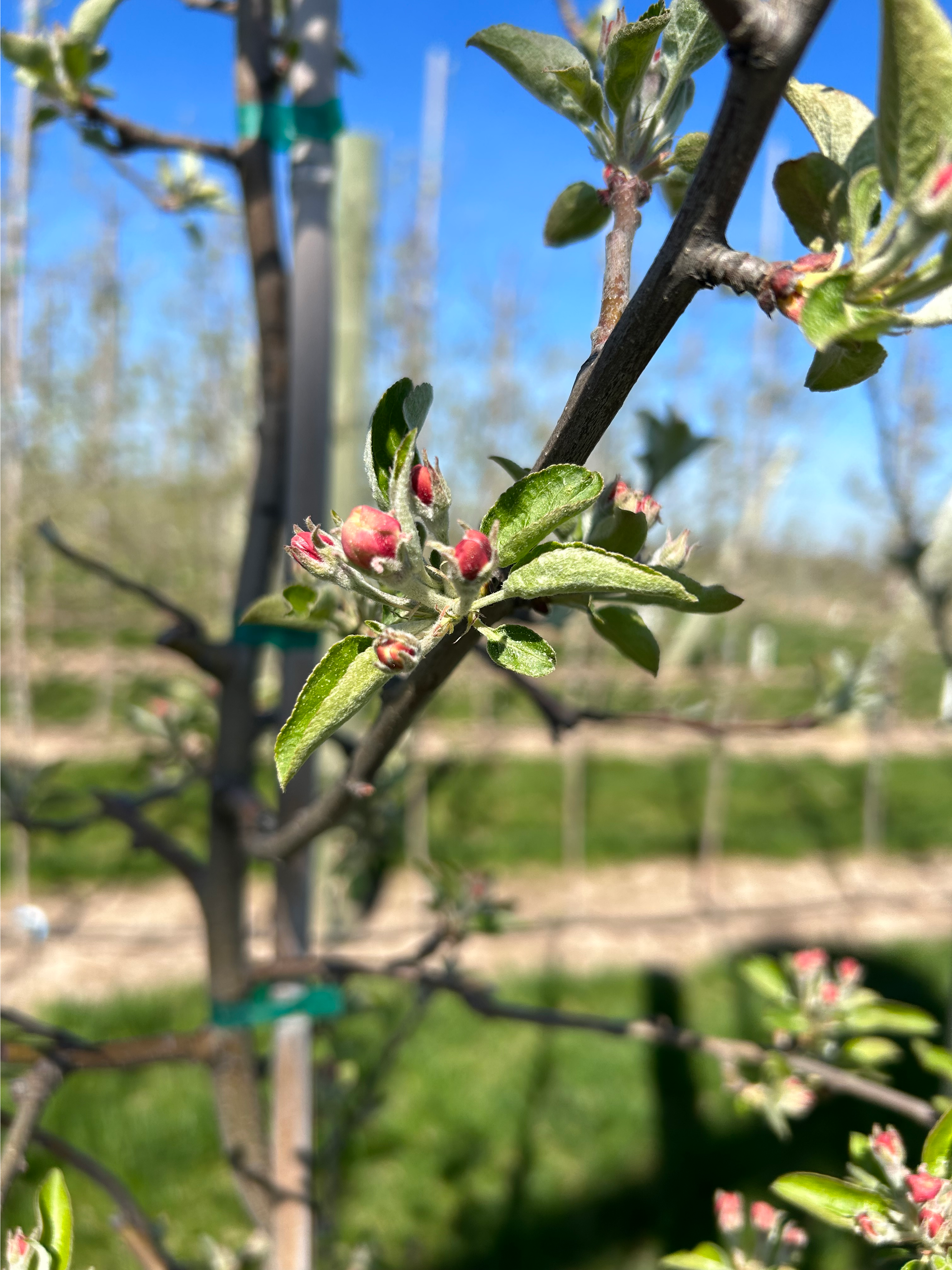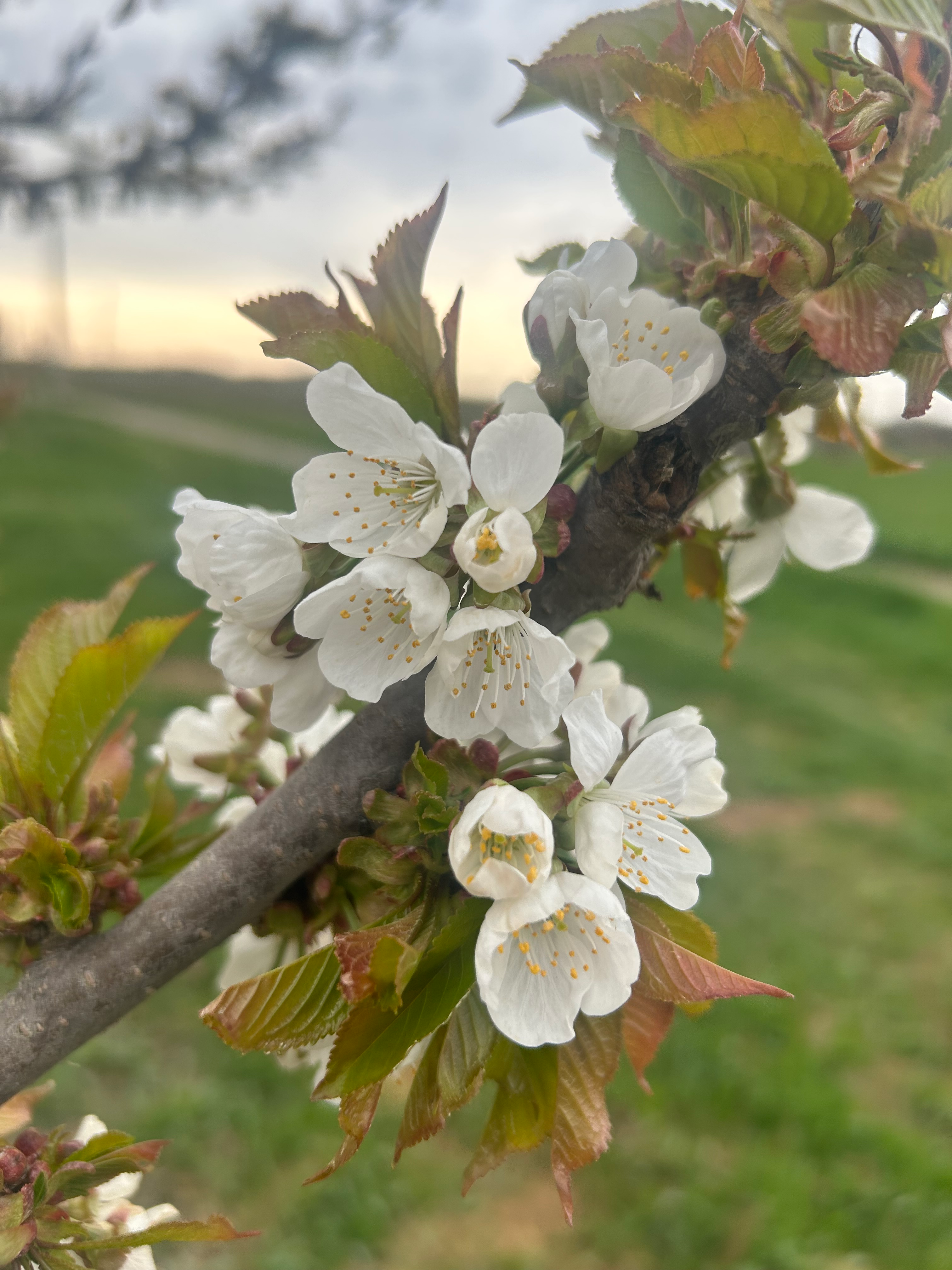Grand Rapids area tree fruit update - April 23, 2024
Bloom is coming in the Grand Rapids region.

Weather update
We have an exciting week of weather coming, which is not necessarily what we want to hear this time of year. There is a chance of thunderstorms Tuesday afternoon, April 23. Any hail associated will not deeply impact fire blight risk this week.
We have cold temperatures upcoming this week. Wednesday morning will have lows around 30 degrees Fahrenheit and Thursday morning will have lows around 28 F in the Grand Rapids, Michigan, area. This has the potential to be damaging at the current growth stages. This resource on critical spring temperatures for tree fruit bud development stages has more details on the specific temperatures of concern.
Frost fans and microsprinklers can be useful tools to mitigate frost damage under the right conditions, but they can also do more harm than good. Be sure to check wind speeds and the temperature inversion potential for your area before using frost fans. Using microsprinklers can be tricky. Keep a close eye on wind speed and avoid sprinklers if the wind speed is above 10 mph. Also, watch out for low dew points/low humidity, which we are anticipating this week. Be sure your sprinkler system can output the required water volume based on the chart in the article “Sprinklers for Frost Protection: What You Need to Know Before Turning Them On” from Virgina Cooperative Extension. This article can also help you decide if sprinkler use will help or hurt.
Additionally, consider this Michigan State University Extension (MSU Extension) article on what fruit growers can do if a freeze is coming.
After this cold stretch, we are anticipating rain throughout this upcoming weekend and a considerable rise in temperatures going forward.
For a detailed look at the upcoming weather forecast, Jeff Andresen, MSU agricultural meteorologist, has weekly 15-minute weather forecasts posted every Tuesday.
Crop update
Apple buds are currently at pink and moving into king bloom this week.

Sweet cherries are in bloom.

Bud development advanced rapidly from last week. With warmer temperatures, there has been a lot of pollinator activity over the past few days. Commercial honey bee and bumble bee hives will arrive in orchards over the next few weeks for pollination of cherry and apple. Honey bees will forage at temperatures at 65 F or warmer. Bumble bees and solitary bees will forage at temperatures 5-10 degrees cooler than honey bees.
As we approach bloom, implement practices that minimize pesticide exposure to bees by using reduced risk pesticides and spraying at times when pollinators are not active. Find tips and guidelines to minimize bee pesticide exposure here.
|
Enviroweather station |
Growing degree day (GDD) accumulation since Jan. 1 as of April 23, 2024 |
5-year average |
||
|---|---|---|---|---|
|
|
GDD42F |
GDD50F |
GDD42F |
GDD50F |
|
Aetna-Fremont |
281 |
102 |
181 |
7493 |
|
Alpine |
332 |
133 |
212 |
88 |
|
Belding |
322 |
129 |
198 |
83 |
|
Conklin |
319 |
125 |
203 |
83 |
|
Grant |
312 |
122 |
189 |
77 |
|
Kent City |
306 |
117 |
181 |
73 |
|
Sparta |
315 |
123 |
191 |
78 |
|
Sparta-Tower |
320 |
125 |
195 |
79 |
|
Sparta-North |
318 |
123 |
200 |
82 |
|
Standale |
361 |
152 |
223 |
94 |
|
McIntosh growth stages |
GDD42F |
GDD50F |
|---|---|---|
|
Open cluster |
284 |
129 |
|
Pink |
367 |
174 |
|
King bloom |
395 |
190 |
We typically report GDD accumulation starting at March 1, but this is not a typical year. We reached the required chilling hours on Jan. 15 to move into ecodormancy and start accumulating GDD. This means the heat we received in February mattered for this year’s crop. As such, I will be reporting GDD from Jan. 1 rather than March 1 this season.
Pest and disease update
Apple scab
Last week, we had two rain events associated with ascospore release. Following the rain event from 1 a.m. – 2 p.m. on April 17, I caught 611 spores per rod. Following the rain event from 10 p.m. on April 18 – 6 a.m. on April 19, I caught 123 spores per rod. This was surprising given that most ascospores discharge during the day. Neither event had a wetting duration long enough for ascospore germination and therefore did not have risk associated with them.
Moving into the rain event this afternoon, approximately 23% of ascospores will be mature.
The rainfall this weekend will be a high-risk time for apple scab with over an inch of rain anticipated over four days. Please ensure that the developing tissue is covered at that time.
Fire blight
As the Grand Rapids area moves into bloom over the next week, please start to think about blossom blight. April 27 and 28 are predicted to be medium risk events. That risk could be exacerbated if the isolated thunderstorms this week result in hail damage.
Powdery mildew
As green tissue is starting to come out, so is powdery mildew. The mycelium overwinters in the buds, which can look feathered, shriveled and silvery-white. The dormant fungus will then colonize this first flush of growth. These appears as “lag shoots. Powdery mildew will also infect developing blossoms and can cause fruit to abort, distort or russet.
Treatment for powdery mildew should be currently ongoing. Keep in mind that while rain benefits other fungal diseases, powdery mildew benefits from dry weather. Be sure to maintain mildew control during dry weather periods too. Plants gain resistance with maturity but will be susceptible to powdery mildew until terminal shoot growth ends.
Insects
Green fruitworm and spotted tentiform leafminer were detected in the Grand Rapids area this week. I have yet to find oriental fruit moth or codling moth in the area. However, oriental fruit moth was caught in southwest Michigan last week. As pink sprays go on this week, please consider these pests.
Keep redbanded leafroller, San Jose scale, European red mite, rosy apple aphid and woolly apple aphid in mind this time of year, too.
For more information about regional reports, please visit the Michigan State University Extension website.



 Print
Print Email
Email




